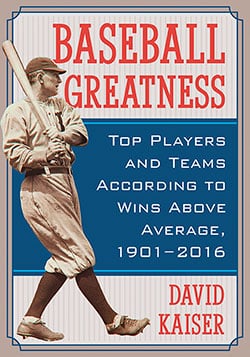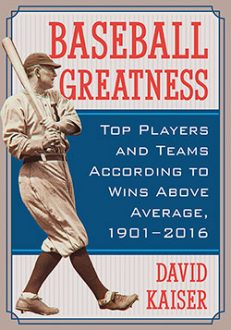Subtotal: $29.95
Baseball Greatness
Top Players and Teams According to Wins Above Average, 1901–2017
Original price was: $35.00.$19.99Current price is: $19.99.
In stock
About the Book
Recent advances in baseball statistical analysis have made it possible to assess the totality of contribution each player makes to team success or failure. Using the metric Wins Above Average (WAA)—the number of wins that the 2016 Red Sox, for example, added because they had Mookie Betts in right field, instead of an average player—the author undertakes a fascinating review of major league baseball from 1901 through 2017. The great teams are analyzed, underscoring why they were successful. The great players of each generation are identified using simple, reliable metrics—from Ty Cobb through Mike Trout, and pitchers from Christy Mathewson to Clayton Kershaw.
Surprises abound. The importance of pitching is found to be vastly exaggerated. Many Hall of Fame pitchers (and some hitters) achieved immortality almost entirely on the backs of their teammates, while a few over-qualified players still await induction. Focusing on today’s rosters, the WAA assessment shows that the game is threatened by an unprecedented shortage of great players.
About the Author(s)
Bibliographic Details
David Kaiser
Format: softcover (7 x 10)
Pages: 250
Bibliographic Info: appendix, notes, bibliography, index
Copyright Date: 2018
pISBN: 978-1-4766-6383-8
eISBN: 978-1-4766-2862-2
Imprint: McFarland
Table of Contents
Acknowledgments viii
Introduction: Great Players, Great Teams 1
1. The Missionary and Lost Generation Era, 1901–1924 23
2. The Lost and GI Generation Era, 1925–1945 43
3. The GI and Silent Generation Era, 1946–1966 70
4. The Silent and Boom Generation Era, 1967–1983 116
5. The Boom and Gen X Era, 1984–2004 145
6. The Gen X and Millennial Era, 2005–2017 189
Epilogue: The Nature of Greatness 220
Appendix 227
Bibliography 230
Index 231
Book Reviews & Awards
- “A must read for all baseball fanatics…Quite possibly the most in depth discussion of baseball success that one could have, and a must have for fantasy baseball players.”— Against the Grain
- “There is much to learn and enjoy…a pleasant ramble through baseball’s long history, written is a way that puts the achievements of the game’s greatest players in the context of their times.”—The Inside Game (SABR Deadball Era Committee Newsletter)
- “Outstanding achievement. Highly recommended”—ARBA
- “Whatever you already think about measuring baseball greatness, Kaiser’s tour de force will blow your mind…. In these days of websites and statistical black boxes and faith-based beliefs, we owe our gratitude to Kaiser, who shows all his work and doesn’t flinch when the facts call for popping a few balloons.”—Rob Neyer, author Power Ball: Anatomy of a Modern Baseball Game
- “Baseball Greatness honors underappreciated all-time great players by better incorporating fielding value for everyday players (e.g., Jimmy Wynn and Keith Hernandez) and filtering out team effects on perceived pitcher value (e.g., Wes Ferrell, Luis Tiant, and Dave Stieb). But more than that, author and real-world historian David Kaiser gives baseball fans a new and sophisticated history of the game: how owners and front office managers have built (and failed to build) great teams; how rare it has been that team greatness has relied on great pitching; and much more.”—Michael Humphreys, author of Wizardry: Baseball’s All-Time Greatest Fielders Revealed
- “The Sabermetric revolution in baseball analysis is no longer in its infancy and the basic principles are now embraced widely in the press, on the air, and by average fans. David Kaiser has done a fine job in clearly explaining the logic behind the calculations and has provided a very welcome synthesis across the various era of Major League Baseball. This book is recommended for those who wish to have a better understanding of the context of modern (and future) baseball analysis.”—Dave Smith, founder, Retrosheet.org
- “Baseball’s stately pace encourages discussions, with ‘Who was better?’ being a favorite topic. David Kaiser’s nominations, making full use of Michael Humphrey’s authoritative solution to the ‘is it fielding or pitching’ defensive dilemma, are presented in a delightful style.”—Richard Cramer, PhD, founder, STATS INC.

 From Girl to Goddess
From Girl to Goddess 




